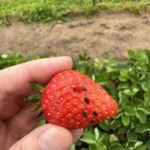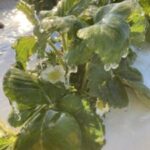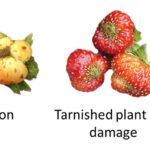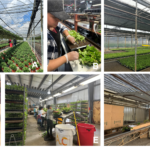A new episode of the Strawberry Chat podcast is available. In this episode, we talked with Dr. Marvin Pritts from Cornell University. We discussed the new edition of the Strawberry Production Guide for the Northeast, Midwest, and Eastern Canada. Dr. Marvin introduced us to the plasticulture day-neutral strawberry product system he has been researching recently.[Read More…]
Removing overwintering leaves on plasticulture strawberries in the early spring is a time-consuming and labor-intensive job. I was asked whether the effort is worthwhile. I want to share my observation that confirms it is worth the effort. We conducted a comparative study on second-year plasticulture strawberries at Southwest Purdue Ag Center in Vincennes, IN. In[Read More…]
Dear Strawberry Chat Listeners, We will talk with Dr. Marvin Pritts on Wednesday, May 1st, 12:00-1:00 pm EST. Dr. Pritts is a professor in the horticulture department at Cornell and a very well-known expert in the strawberry industry. Many of you may have heard and read the book Strawberry Production Guide for the Northeast, Midwest,[Read More…]
In addition to frost protection, disease management is pivotal during the blooming stage, particularly concerning gray mold (caused by Botrytis spp.) and Anthracnose. To protect the fruit, fungicide application should commence at or even before blooming. The pressure of both diseases is heavily influenced by weather conditions, with Botrytis favoring wet and cool climates and[Read More…]
This article was written on April 17. Harvesting of high tunnel-grown strawberries has started from southern to central Indiana. Early cultivars in open-field plasticulture are fruiting in southern Indiana, with harvest right around the corner. The crops are generally a week earlier than last year. Late cultivars, second-year patches, and fields covered with straw in[Read More…]
Overwintering strawberries in high tunnels can jumpstart plant growth in the spring and protect developing flowers from frost damage and disease. However, this protected environment is also ideal for some pests, like spider mites and aphids, that can successfully overwinter and build their populations. We conducted an experiment on ‘Chandler’ strawberry where it was grown[Read More…]
Attention strawberry growers, A group of scientists are conducting a survey about growers’ current practices and opinions about agricultural mulches in their strawberry fields. They hope growers could share with the research team information about current practices and opinions about different types of agricultural mulches by completing a short online survey. The survey is located[Read More…]
This summer, we interviewed four farmers growing strawberries in plasticulture in Indiana. Their business is on different scales, and they sell through varied market channels. How do strawberries fit into their overall crop and market strategy? What are the opportunities and challenges? The lessons the experienced farmers share will be of great value to others[Read More…]
I visited Kube-Pak (Allentown, NJ) during North American Strawberry Growers Summer Tour. Kube-Pak wholesales bedding plants, plugs, potted plants and more. Our visit is at Kube-Pak’s peak time of strawberry business. Mr. Rob Swanekamp showed us the steps of growing strawberry plugs, from tip production to shipping. The strawberry plugs’ shipping date starts in mid-July[Read More…]
Strawberries are traditionally grown with a matted-row system in Indiana. Plasticulture is relatively new. It brings market opportunities and potentially high income. However, growing strawberries in plasticulture is much more expensive than the matted-row system. Farmers need a good understanding of the system to avoid significant economic loss. In the Strawberry Chat Podcast episodes, you[Read More…]




